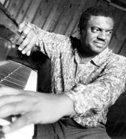
Comment
on this story
What:
Mulgrew Miller with the Knoxville Jazz Orchestra
When:
Tuesday, Oct. 7, 8 p.m.
Where:
Fairbanks (now located on Homberg Drive)
Cost:
$15, $8 students
|
|

Pianist Mulgrew Miller showcases his talent with the KJO
by Jonathan B. Frey
Seems whenever pianist Mulgrew Miller comes to town, it involves Big. His last appearance in Knoxville, some 10 years ago, was when four pianos, five pianists (Miller, Donald Brown, James Williams, Harold Mabern, and Geoff Keezer), a bass, and a bassist (Christian McBride) converged on the Bijou stage to celebrate the work of Memphis pianist Phineas Newborn, Jr. (Come to think of it, the Bijou hadn't seen the likes of such since the decade before when minimalist composer Steve Reich situated six marimbas on that same stage—a likewise visually imposing, weight-limit testing, musically entrancing evening.) On Oct. 7, Miller performs with the Knoxville Jazz Orchestra, a behemoth in its own right, performing at the recently relocated Fairbanks in Homberg Place.
Miller's career gives the impression of his having performed with just about every other jazz entity on the planet except the KJO. With more than 400 leader and sideman recordings to his credit over 25 years, it might be easier to identify whom he hasn't played with rather than list who he has. Nevertheless, the short list of his associations includes Art Blakey, Gary Burton, Betty Carter, Ron Carter, Larry Coryell, Benny Golson, Freddie Hubbard, Branford Marsalis, David Sanborn, Steve Swallow, Tony Williams, Cassandra Wilson ... a veritable who's who of jazz, cutting across generational and stylistic lines. On the phone from his home in Easton, Pa., Miller waxes grateful: "You know I'm one of the luckiest guys in the world; I've played with everybody I wanted to play with, with the exception of Sonny Rollins and Wayne Shorter." And Miller's not yet 50; there's time.
Asked about his good fortune as well as having been voted the most in-demand pianist by his peers in a 1995 New York Times poll, Miller muses: "Well, I don't really know.... I can say I came to New York at a time when a lot of records were being made by a lot of record companies, and they were recording a lot of people, both young and old. And I was kinda in the crux of that, in a good time, and so I had a lot of working relationships with both veteran and young musicians. I was able to record in both, everybody from Benny Golson, Art Blakey, James Moody, Kenny Garrett.... Also because I come prepared to be a team player, I come with spirit of being a team player in the rhythm section. And so, you know, obviously I didn't make all those records because I was the greatest piano player in the world. There are scores of really excellent piano players in New York. But maybe there might have something that stood out by the way I functioned in the rhythm section."
Miller's modesty aside, team player is an apt description. Whether it be on veteran bassist Ron Carter's 2003 trio release (The Golden Striker, with Russell Malone on guitar), in a relative newcomer's sextet (trumpeter Jim Rotondi's 2001 Destination Up, for just one example), or with his own groups, Miller's sensitivity as an accompanist is everywhere in evidence, ultimate simpatico made manifest. Miller clearly finds the accompanist role a rewarding challenge: "You have to realize the creativity in [comping]. It's not just sitting there dropping chords, there's creativity in accompanying. And unless you hold that view or have that experience, it might not be as fulfilling a 'duty' as soloing would be."
If there's a fly in the ointment, it's been the scarcity of Miller's recordings as a leader. His 1980s Landmark sides and 1990s RCA/Novus titles are out of print, as are reissues by the now-defunct 32 Jazz label. And while "it was a conscious decision to take a step back and not have to deal with the pressures of record labels and all of that" for the past seven years—a time during which Miller appeared on over 200 recordings as a sideman—fortunately, his hiatus as a leader is over. We continue to wait for such under-appreciated gems as the 1988 release The Countdown (with Tony Williams, Ron Carter, and Joe Henderson) to re-surface from the Landmark vaults, but meantime there's an upcoming trio recording slated for January as well as last year's The Sequel, which features Miller's bluesy, in-the-pocket piano lines in the context of his sextet Wingspan.
Not surprisingly, Miller's no stranger to the large format either, having played in the 1970s with the Duke Ellington Orchestra, in the 1990s with the Lincoln Center Jazz Orchestra, and recently with a number of university bands (in March with the University of Memphis jazz orchestra). But the KJO appearance will be a first, and an opportunity for both to shine on Miller originals, arranged for big band by Memphis-born trumpeter Bill Mobley, along with tunes by Art Blakey and Duke Ellington.

October 2, 2003 * Vol. 13, No. 40
© 2003 Metro Pulse
|